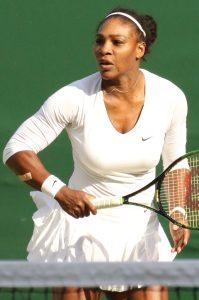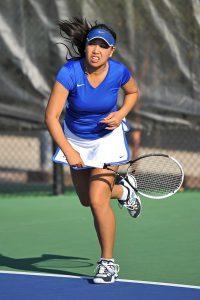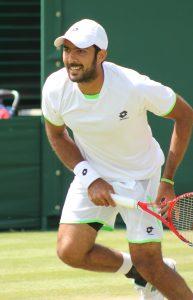We may earn money or products from the companies mentioned in this post.
Introduction

Tennis is a captivating sport that has captured the hearts of millions around the world With its rich history and global popularity, tennis has become a thrilling spectacle that showcases athleticism, skill, and strategy The physical demands of tennis require players to be at their peak fitness level in order to excel on the court
A Brief Overview of Tennis as a Sport
Tennis has a fascinating history that dates back to ancient times The modern game we know today evolved from various forms of ball games played by ancient civilizations such as the Egyptians, Greeks, and Romans In the 19th century, tennis gained significant popularity in England and soon spread worldwide
Today, tennis is played at both amateur and professional levels, attracting players of all ages and abilities It is renowned for its competitive nature, intense rallies, and strategic gameplay Whether it’s singles or doubles matches, every aspect of tennis requires mental agility, quick reflexes, and excellent hand-eye coordination
The Physical Demands of Tennis
Tennis is undoubtedly one of the most physically demanding sports out there Players must possess exceptional cardiovascular endurance to sustain long matches that can go on for hours They need explosive power for powerful serves and shots while maintaining agility to cover vast areas of the court swiftly
The sport places tremendous strain on players’ joints due to repetitive movements like running, jumping, pivoting, and sliding Additionally, the constant stop-and-start nature of tennis requires athletes to have remarkable muscular strength in order to generate power in their strokes
Importance of Fitness in Tennis

In order to perform at their best on the court, tennis players must prioritize their fitness levels Both injury prevention and optimal performance are heavily dependent on maintaining a high standard of physical fitness
Injury Prevention
Tennis involves a wide range of movements that put players at risk of various injuries Ankle sprains, knee problems, shoulder issues, and back pain are common ailments faced by tennis players By focusing on fitness training, individuals can strengthen the muscles surrounding these vulnerable areas, reducing the likelihood of injuries
Furthermore, improving flexibility through stretching exercises can enhance joint mobility and minimize strain on tendons and ligaments during quick directional changes or powerful strokes Core stability training is also crucial for maintaining proper posture and minimizing stress on the spine
Optimal Performance
Fitness directly impacts a player’s ability to perform optimally during matches Stamina is crucial for enduring long matches without fatigue affecting performance A well-conditioned athlete will have more energy reserves to execute shots with precision even in the latter stages of a match
Enhancing speed and agility can give players an edge by allowing them to reach difficult shots more effectively and recover quickly after each stroke Strength training improves shot power while also contributing to overall stability and balance on the court
In conclusion, tennis is not only a mentally challenging sport but also physically demanding Being fit is essential for injury prevention as well as achieving peak performance levels Through proper fitness training, athletes can unlock their full potential on the tennis court
Components of Fitness Involved in Tennis

Cardiovascular Endurance
Cardiovascular endurance is a vital component of fitness, referring to the ability of the heart, lungs, and blood vessels to deliver oxygen to working muscles during physical activity In tennis, cardiovascular endurance plays a crucial role as players engage in fast-paced rallies and explosive movements across the court
Tennis serves as an excellent sport for improving cardiovascular endurance due to its high-intensity nature The constant movement, quick sprints, and rapid changes in direction elevate the heart rate and challenge the cardiovascular system Additionally, the duration of games, sets, and matches in tennis requires sustained effort over extended periods
Muscular Strength and Endurance
Muscular strength refers to the maximum force that a muscle can generate, while muscular endurance focuses on a muscle’s ability to perform repetitive contractions over an extended period without fatigue Both components are essential for tennis players who need power for shots and endurance to sustain performance throughout long matches
Tennis engages various muscle groups throughout the body Upper body muscles such as shoulders, chest, and back are utilized during serves and overhead shots Lower body muscles like quadriceps, hamstrings, and glutes are crucial for quick movements on the court Core muscles comprising abdominals and lower back provide stability during strokes
To build muscular strength and endurance specifically for tennis players, training methods may include resistance exercises like weightlifting or using resistance bands Incorporating plyometric exercises can improve explosiveness while performing agility drills helps enhance overall muscular endurance
Flexibility
Flexibility refers to the range of motion around a joint or group of joints In tennis, flexibility plays an important role in executing efficient strokes with proper technique while reducing the risk of injuries
Tennis enhances flexibility through dynamic stretching during the warm-up routine Dynamic stretches involve controlled movements that mimic the actions performed during a tennis match, preparing the muscles for the demands ahead Additionally, static stretching after a match or practice session helps improve overall flexibility and aids in muscle recovery
This content highlights the key components of fitness involved in tennis – cardiovascular endurance, muscular strength and endurance, and flexibility Each component plays a crucial role in enhancing a player’s performance on the court By focusing on these aspects, tennis players can improve their overall fitness levels and excel in their game
Analysis of Other Fitness Components Relevant to Tennis

Power/Explosiveness
Power and explosiveness are crucial aspects of fitness in tennis They enable players to generate the necessary force for powerful shots and quick movements on the court In tennis, power refers to the ability to generate maximum force, while explosiveness is the capacity to apply that force rapidly
Tennis helps develop power and explosiveness through various techniques One such technique is serving, which requires a combination of strength, speed, and coordination to deliver high-speed serves Additionally, returning shots with force demands explosive leg power and upper body strength
Agility
Agility is another essential fitness component in tennis as it allows players to move quickly and efficiently around the court It involves rapid changes in direction, balance, and coordination
Tennis promotes agility through specific movements required during gameplay Lateral movement on the court, such as shuffling from side to side or executing quick lateral steps, helps improve agility by enhancing footwork and reaction time Furthermore, quick direction changes when chasing down shots or adjusting positioning contribute significantly to developing agility skills
Coordination/Balance
Coordination and balance are fundamental aspects of successful tennis play as they directly impact shot accuracy and overall performance on the court
In tennis, coordination refers to the synchronization of different body parts working together harmoniously during strokes or movements Balance relates to maintaining stability while executing various shots or navigating across the court
Hitting groundstrokes accurately requires precise hand-eye coordination along with proper body positioning for optimal balance throughout each stroke’s execution Similarly, volleying at the net necessitates excellent coordination between hand-eye movement and weight transfer for timely shot placement
Training Methods and Recommendations for Tennis Players

When it comes to training for tennis, there are several key areas that players should focus on to improve their performance on the court These include cardiovascular endurance, strength and conditioning, flexibility, agility, coordination, and balance By incorporating a variety of training methods into their routine, tennis players can enhance their overall fitness and excel in their game
Cardiovascular Endurance Training
In order to sustain the high-intensity demands of tennis, cardiovascular endurance is crucial Two effective training methods for improving this aspect are high-intensity interval training (HIIT) and continuous aerobic exercise
With HIIT, players alternate between short bursts of intense activity and brief recovery periods This not only helps to build stamina but also mimics the intermittent nature of tennis matches Continuous aerobic exercise such as running or cycling at a moderate intensity for an extended period can also improve cardiovascular fitness
Strength and Conditioning
A strong foundation of strength and conditioning is essential for tennis players to generate power in their shots and move efficiently on the court Resistance training programs that incorporate both weightlifting exercises and bodyweight exercises can be highly beneficial
Weightlifting exercises like squats, deadlifts, and bench presses help build overall strength while targeting specific muscle groups used in tennis movements Bodyweight exercises such as push-ups, lunges, and planks contribute to functional strength development
In addition to resistance training, core workouts are crucial for stability and power generation during strokes Exercises like Russian twists, bicycle crunches, and plank variations strengthen the core muscles necessary for maintaining balance while hitting powerful shots
Flexibility Improvement Techniques
Tennis requires a wide range of motion in various joints to perform strokes effectively Flexibility improvement techniques can enhance players’ ability to move fluidly and prevent injuries
Dynamic stretching involves moving through a full range of motion in a controlled manner, warming up the muscles and increasing flexibility Static stretching, on the other hand, involves holding stretches for an extended period to elongate muscles and improve flexibility
Incorporating practices like yoga or Pilates into training routines can further enhance flexibility while also promoting mental focus and relaxation
Agility, Coordination, and Balance Drills
Tennis requires quick movements, precise footwork, and excellent balance Incorporating agility, coordination, and balance drills into training routines can significantly improve on-court performance
Footwork ladder drills help develop speed, agility, and coordination by practicing various foot patterns Cone or marker-based drills challenge players’ ability to change direction quickly while maintaining control over their movements Exercises using a balance board or Bosu ball target stability and balance, crucial elements for executing shots with accuracy
Tailoring Fitness Programs According to Individual Needs
To maximize the benefits of training programs, it is essential to tailor them according to individual needs Factors such as age, gender, skill level, and specific goals should be considered when designing personalized fitness plans for tennis players
Working closely with coaches or trainers who have expertise in tennis-specific conditioning can ensure that programs are optimized for each player’s unique requirements This personalized approach allows individuals to focus on areas of weakness while capitalizing on their strengths for improved overall performance
Useful Links

Skill-Related Fitness Components and Athletic Performance
Tennis Fitness Blog
11 Components of Fitness: Health & Skill-Related
1 EXERCISE GUIDELINES A. Health-related components …
Components of Fitness
What are the different components of fitness
Health & Skill Related – components of fitness
Components of Health & Skill-Related Fitness
Health-Related Components of Fitness – Windell Spivey
The 11 components of fitness – Keeping fit and healthy …
The Components of Fitness in Sports- What are they?
Tennis – health benefits
Components of Fitness multiple choice Flashcards
Physical Education Fitness Plan Study Guide
GCSE PE: COMPONENTS OF FITNESS
11.3: Health Related Components of Physical Fitness
Components of fitness
Components of Fitness
Components of Fitness






